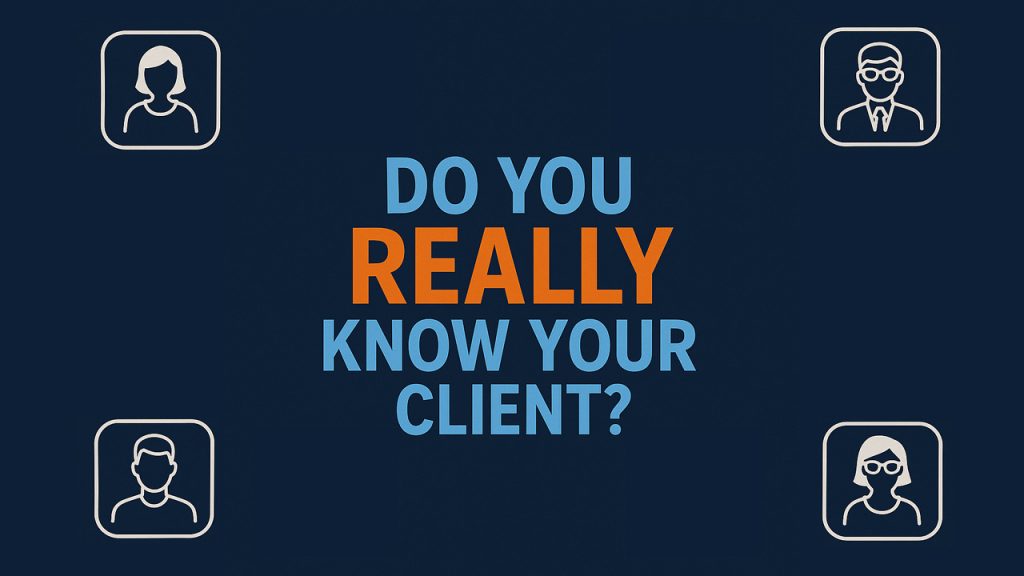
Do You Really Know Your Client?
Let’s cut to the chase: Most business owners don’t actually know who they’re marketing to.
I know, that might sting a little. But after working with hundreds (maybe thousands) of entrepreneurs over the years, I’ve seen this play out over and over again. Someone launches a product, builds a slick website, sends out a few emails, runs an ad or two… and then they sit back and wonder why nothing’s working.
They’ve done everything right — at least on paper. But it all falls flat. No clicks. No calls. No conversions.
And almost every time I dig into what’s going on, we uncover the same root issue:
They don’t really know who their client is.
Not in the “age, gender, income bracket” sense. I mean really know them — like what they’re struggling with at 2 AM, what motivates them to take action, what words they use when they talk about the problem you’re trying to solve.
I remember seeing an interview with Comedian/Actor Robin Williams in which the host asked him how he got in character for a part. He mentioned that he would think about who the person was, how they might talk, and such, but what caught my attention was that he would even think about what that person would carry in their wallet.
That made an impact on me and my business. When I correspond with a customer via email or on web pages, I try to think about what type of person would be reading/viewing right now. What is their walk of life, and how can I, even for a moment, become a part of that world to relate with them right where they are?
See, too many people build their marketing from the wrong starting point. They start with the product. Or the platform. Or worse… they start with themselves.
You Are Not Your Client
Let me say this as clearly as I can:
You are not your ideal client.
 I know you’re passionate about what you do. You might even be your own first customer — maybe you built your business around a problem you personally solved. That’s great. But once you turn it into a business, you have to stop marketing like you’re selling to a mirror.
I know you’re passionate about what you do. You might even be your own first customer — maybe you built your business around a problem you personally solved. That’s great. But once you turn it into a business, you have to stop marketing like you’re selling to a mirror.
Because when you start thinking, “Well, I would buy this,” you fall into a dangerous trap.
You start writing copy that makes sense to you, not to the person you’re actually trying to reach. You focus on features you care about. You show up on platforms you like. You make design choices that match your style.
The result? Your entire marketing strategy is tailored to a person who already understands, trusts, and believes in your offer — you.
Funny story about that. Or maybe just an eye-opener. Early on, most of my websites were ORANGE. I mean an Orange background with a sales-type page down the center with orange highlights etc. UNTIL… A customer and friend spoke up and said, Man, I almost didn’t buy your product. All that Orange just hurt my eyes. So much I just couldn’t focus.
You see I was designing based on what I would like not what would appeal to my following or potential customers.
So, unless you’re planning to buy enough of your own product(s) to keep the lights on, that’s a serious problem.
“Everyone” is Not a Strategy
Here’s another one I hear all the time:
“My product is for everyone.”
Nope. It’s not.
If you think your offer is for everyone, that’s a red flag that you don’t have a real handle on your target market. Because trying to appeal to everyone means you’ll end up connecting with no one.
Why? Because “everyone” doesn’t have the same problem. They don’t think the same way, use the same words, or care about the same outcomes. When you try to make your messaging universal, it turns vague and watered down. It becomes safe, generic, and forgettable.
Think about it this way: The tighter your focus, the sharper your message. When you know exactly who you're talking to, you can use language that hits them in the gut — language that makes them nod their head and think, “Finally. Someone gets it.”
The Real Question: Who Do You Help Best?
Instead of asking, “Who could use this?” try asking, “Who do I help best?”
There’s a big difference.
Your ideal client is the person who gets the most value from what you offer — the one who has the problem you solve feels the urgency to fix it, and is willing to invest in the solution. They’re the people who are out there right now looking for someone exactly like you, but they can’t find you… because your message is too vague.
If you’re trying to be the solution to everybody, you’re invisible to the people who need you most.
So take a step back and really dig into this:
- What keeps your ideal client up at night?
- What problem are they sick and tired of dealing with?
- What language do they use when they describe that frustration?
- Where are they already hanging out online?
- Who do they trust?
When you get crystal clear on that, your marketing starts to shift. It stops being guesswork and starts becoming a real conversation. One that resonates. One that converts.
Mirror Their Problem, Not Your Product
There’s an old marketing truth that still holds up:
If you can describe someone’s problem better than they can, they’ll assume you have the solution.
Let that sink in.
You don’t need to show off how smart you are. You don’t need to flood them with features or explain every detail of your process. You just need to show them that you understand. That you see them.
That’s what builds trust. That’s what turns heads.
So instead of leading with what you do, lead with what they’re going through. Paint a picture of their current reality. Let them know you’ve walked that path before — or that you’ve helped others who have.
Once they feel understood, they’ll start to wonder, “Okay… what do you recommend?” That’s when your offer becomes relevant. That’s when they’re ready to listen.
Stop Throwing Darts in the Dark
Let me put it another way.
Imagine you’re throwing darts. But you’ve got a blindfold on. You don’t know where the target is. You’re just tossing them and hoping one sticks.
That’s what marketing feels like when you don’t know your client.
But once you understand exactly who you’re trying to reach — and what they’re going through — it’s like someone turns the lights on. Now you’re aiming with intention. You’re hitting the bullseye. You’re not wasting energy guessing.
And let me tell you… that’s where the magic happens.
Talk to Real People
Still not sure who your ideal client is? Go talk to your current ones.
Seriously.
Pick up the phone. Schedule a Zoom. Send a quick email with a few questions.
Ask them why they bought from you. What problem they were trying to solve. What almost kept them from pulling the trigger. What they were feeling before and after they worked with you.
These conversations will give you more insight than any analytics report ever will.
And here’s the best part: When you start using their words in your marketing — not your words, not fancy marketing lingo, but the real, raw language they use — your message becomes magnetic. It pulls in more people just like them.
Final Thoughts
At the end of the day, marketing isn’t just about getting attention — it’s about getting attention from the right people. And that only happens when you know exactly who you’re talking to.
So if your marketing isn’t hitting, if your emails are going unopened or your landing page bounce rate is sky high, don’t blame the platform or the algorithm just yet.
Go back to the foundation.
Ask yourself the hard question:
Do I really know my client?
Because once you do — once you really know them — the rest starts falling into place.
If you’ve connected with this article you might check out my book “50 Biggest Online Business Mistakes".
